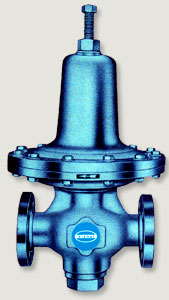| |
Pressure Reducing Valve (PRVJN)

|
 Prev Prev |
| |
 |
Pressure Reducing Valves are required in large quantities
across several industries to provide constant set pressure
as per site requirements.
These are used for regulating air, water, steam, nitrogen,
natural gas & other gases.
|

|
Balance valve design for constant set pressure. |
 |
Top and bottom guiding of the Main Valve for proper seating. |
 |
Provision of reversible valve disc for renewed life. |
 |
Minimum number of moving parts ensuring reduced maintenance. |
 |
Wider range of down-stream pressure. |
 |
Range of body & elastomer material combinations to meet majority of process applications. |
 |
Provision of sensor for smooth throttling action. |
 |
Long plug stroke for full flow across the relief zone. |
 |
Designed ruggedly to withstand shocks. |
 |
Simple and economic design. |
 |
Sizing Co-efficient Cg/Cv based upon “Universal Sizing Equation” |
|
|
Specifications (MOC)
 |
|
Body, Bonnet |
: |
CI / CCS / CF8 / CF8M |
|
Wetted Parts |
: |
SS316 |
|
Elastomers |
: |
Nitrile / Neoprene – Temp: -29 to + 82 Deg C |
|
|
|
PTFE / SS – Temp: -200 to + 260 Deg C |
|
Spring |
: |
Spring Steel |
|
| |
Pressure Rating & Sizing Details
 |
Size Range &
Style |
Ratings / Schedules |
Working Pressure*
Kg/cm2 |
Reduced Pr. Range*
Kg/cm2 |
½” – 2”
Screwed |
1”-3”
Flanged |
Sch 40
ANSI 150# |
21 |
0.6-10 |
Sch 80
ANSI 300# |
35 |
2.5-18 |
|
* High inlet pressures & wide range of outlet pressures available on request. Consult factory for detailed information.
Note: Minimum delta P shall be 1 Kg/cm2g |
| |
Operation
 |
The operation is based on the fundamentals of equilibrium where the spring load acting downwards is balanced by the discharge of secondary pressure beneath the diaphragm.
When the spring is compressed, it opens the main valve to allow fluid downstream zone.
The downstream pressure enters the diaphragm chamber through the sensor where the pressure equalizes the spring load as equilibrium is restored.
A small diaphragm is also provided to balance the variations in the inlet pressure, thus maintaining a constant set point. |
| |
Installation
 |
For satisfactory performance from a PRV, some important points must be considered while installing the instrument: |
|
Use of Strainers on the upstream line to prevent debris from entering the valve internals, thus providing enough Protection. |
|
Provision of an adequate Safety Valve on the downstream line for protection to the pipe line from any increase in pressure which may be harmful & should be installed about 18-20 pipe dia. away from the location of PRV |
|
Positioning the PRV at a convenient height for easy access & maintenance & should be as near as possible to the consumption vessel |
|
| |
|
| |
